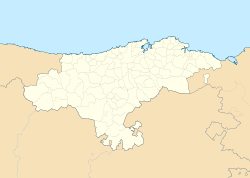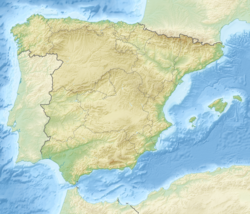Cave of Chufín
This is an old revision of this page, as edited by Francis Schonken (talk | contribs) at 14:38, 22 June 2018 (Undid revision 785887330 by Mike Peel (talk) restore, repair). The present address (URL) is a permanent link to this revision, which may differ significantly from the current revision.
This article does not cite any sources. Please help improve this article by adding citations to reliable sources. Unsourced material may be challenged and removed. Find sources: "Cave of Chufín" – news · newspapers · books · scholar · JSTOR (October 2010) (Learn how and when to remove this message) |
| UNESCO World Heritage Site | |
|---|---|
 | |
| Location | Riclones, Rionansa, Cantabria, Spain |
| Part of | Cave of Altamira and Paleolithic Cave Art of Northern Spain |
| Criteria | Cultural: (i), (iii) |
| Reference | 310bis-007 |
| Inscription | 1985 (9th Session) |
| Extensions | 2008 |
| Buffer zone | 16.65 ha (41.1 acres) |
| Coordinates | 43°17′26″N 4°27′29″W / 43.29056°N 4.45806°W / 43.29056; -4.45806 |
The cave of Chufín located in the town of Riclones in Cantabria (Spain). It is located in the place of confluence of the Lamasón and Nansa rivers in an environment with steep slopes where there are several caves with rock art. It is one of the caves included in the list of World Heritage of UNESCO since July 2008, within the site «Cave of Altamira and Paleolithic Cave Art of Northern Spain».
It was discovered by the photographer Manuel de Cos Borbolla, natural of Rabago (Cantabria)
In Chufín found different levels of occupation, the oldest being around 20000 years old. The cave, small size, has some deep sentillez subtle engravings and paintings from red deer, goats and cattle that are represented very schematically.
It also found a large number of symbols. One group, called type "sticks", accompanies the paintings inside animals. There is also a large number of drawings using points (puntillaje), including one which has been interpreted as a representation of a vulva.
See also
External links
- Human Timeline (Interactive) – Smithsonian, National Museum of Natural History (August 2016).
| Taxonomy (Hominins) |
| ||||||||||||||||||||||||||
|---|---|---|---|---|---|---|---|---|---|---|---|---|---|---|---|---|---|---|---|---|---|---|---|---|---|---|---|
| Ancestors |
| ||||||||||||||||||||||||||
| Models |
| ||||||||||||||||||||||||||
| Timelines | |||||||||||||||||||||||||||
| Others | |||||||||||||||||||||||||||
Prehistoric cave sites, rock shelters and cave paintings | |||||||||||||||||||||||||||||||||||||||||||||||||||||||||||||||||||
|---|---|---|---|---|---|---|---|---|---|---|---|---|---|---|---|---|---|---|---|---|---|---|---|---|---|---|---|---|---|---|---|---|---|---|---|---|---|---|---|---|---|---|---|---|---|---|---|---|---|---|---|---|---|---|---|---|---|---|---|---|---|---|---|---|---|---|---|
| |||||||||||||||||||||||||||||||||||||||||||||||||||||||||||||||||||
| |||||||||||||||||||||||||||||||||||||||||||||||||||||||||||||||||||
| |||||||||||||||||||||||||||||||||||||||||||||||||||||||||||||||||||
| |||||||||||||||||||||||||||||||||||||||||||||||||||||||||||||||||||
| |||||||||||||||||||||||||||||||||||||||||||||||||||||||||||||||||||


